This one is embarrassing. I should know better. In fact, I do know better. It’s just that from afar this small branch of Burgundy plum didn’t look like it had an overwhelming amount of fruit on it. Only once I looked closely did I see that the branch had broken:
And then I lifted it up only to discover that the branch was three times as long as I’d thought and was carrying five times as much fruit as I had seen from afar. The branch had been weighed down by all of the fruit that I hadn’t seen and was hiding it behind and under another branch. This is what I saw every time I walked by:
I immediately stripped all of the fruit off the branch in the hope that it wouldn’t die. Turns out that this little branch of a finger nail’s diameter was carrying these 59 plums:
It’s a wonder the branch hadn’t snapped off entirely.
This is a special, singular branch. The tree from a few steps back actually looks like this:
It’s a Dapple Dandy pluot tree that I’d grafted that one little branch from my mom’s Burgundy plum onto. It’s the only branch of Burgundy plum I have, and Burgundy plums are not only wonderful tasting fruit, but the Burgundy’s blossoms are needed to pollenize the Dapple Dandy. Maybe the branch will survive and bloom next year to do its pollenization work, and this winter I’ll try to graft a new Burgundy branch onto the tree elsewhere.
The lesson
The lesson in this for me is not that I should thin my fruit — I already knew that. And I had already done a round of thinning fruit on this tree. The lesson is to get into trees and lift branches and make sure you really know what each branch is carrying so you can thin the fruit properly.
Stage two: Well, I better get in there and lift branches on the rest of the Dapple Dandy pluot tree. Maybe some of those are hiding fruit I haven’t noticed.
My goodness, were they ever! Here’s how many I removed from the Dapple Dandy branches:
Better late than never? No pluot branches had broken. That’s the good news today.
Thinning fruit generally
How much fruit should you thin? It depends on the type of tree and your preference for fruit size. For large fruits that often grow on thin branches, like peaches, it’s good to thin more. For small fruits that often grow on thick branches, like apricots, it’s not as necessary to thin as much. My guiding principles is: Remove enough fruit such that a branch will not break or bend down from the weight of the fruit so much that the fruit or branch will get sunburned. I personally don’t thin fruit aiming to get the fruit on the tree to grow as large as possible — a goal for some people. For one, I’ve never noticed that such a practice actually works. But also, I don’t like giant peaches or apples or any other kind of fruit. I prefer small fruit, because if I want more I’ll pick another one.
Here is a good and short video from Tom Spellman at Dave Wilson Nursery showing him thinning a Burgundy plum and talking about a few thinning principles. Skip to about 2:45 into the video to see the Burgundy plum.
And when you do your thinning, make sure to stick your head inside the tree and lift branches and find out for sure how much each branch is carrying, Greg!
You might also like to read:


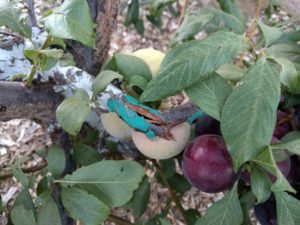
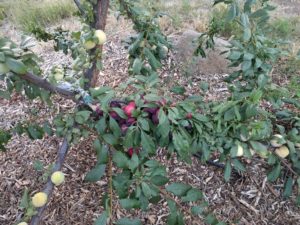
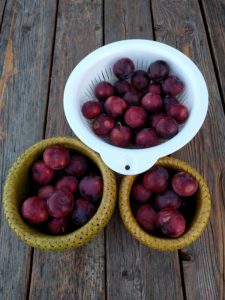
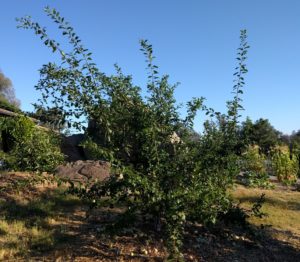
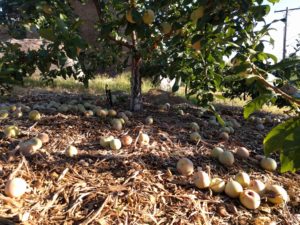


Thanks for the insight!
I know this is old so not sure you’ll see this but for 10 years are plum tree produced no fruit. It grew well, we kept it pruned, and it blossomed every spring but late frosts typically nullified any production. Last fall I tried something different, I used the big box fruit tree fertilizer spikes and this year the tree produced, without exaggeration 70 to 80 plums on each 3 to 4 foot section of branch. We were excited and thought the tree would thin itself and to a small extent it has but we should have helped with the thinning I see now. Anyhow, looks like the plums have ripened where the sun hits the fruit but the backside the skin is a brownish color and obviously rotten, what strikes me as odd is there are also solid green sections that indicate it is not ripe. So, one one small, slightly larger than a golf ball size plum I have half ripe, quarter rotten, and quarter not ripe. What would cause a small plum to ripen at such different rates ? I’m sure it has something to do with thinning but would like to better understand why. Happy to send pictures if that would help. Thank you.
I have a burgundy plum tree that is 6 years old. This is the first year it has produced more than one or two fruits. The plums do not seem to be ripening. I thought I was not letting them hang long enough, and sometimes I will pick one that is pretty sweet. However the majority of the fruit is pretty tart. Is this a maturity issue? As in the fruit will be better quality as the tree matures? thank you.
Hi Dan,
That’s weird and disappointing. I’ve never heard this problem with Burgundy. Six years is long enough for the tree to be performing properly. I would say that you shouldn’t waste any more time on it. The variety could be unsuitable for your location, the rootstock could be unsuitable, the tree could have been mislabeled, who knows. Regardless, I would replace it either with another Burgundy (if you really want to try that variety again) or with a different variety.
My own Burgundy plums have slightly tart skin and flesh when they’re immature but there’s almost no tartness detectable anywhere once they’re mature and the flesh inside is deeply burgundy in color.